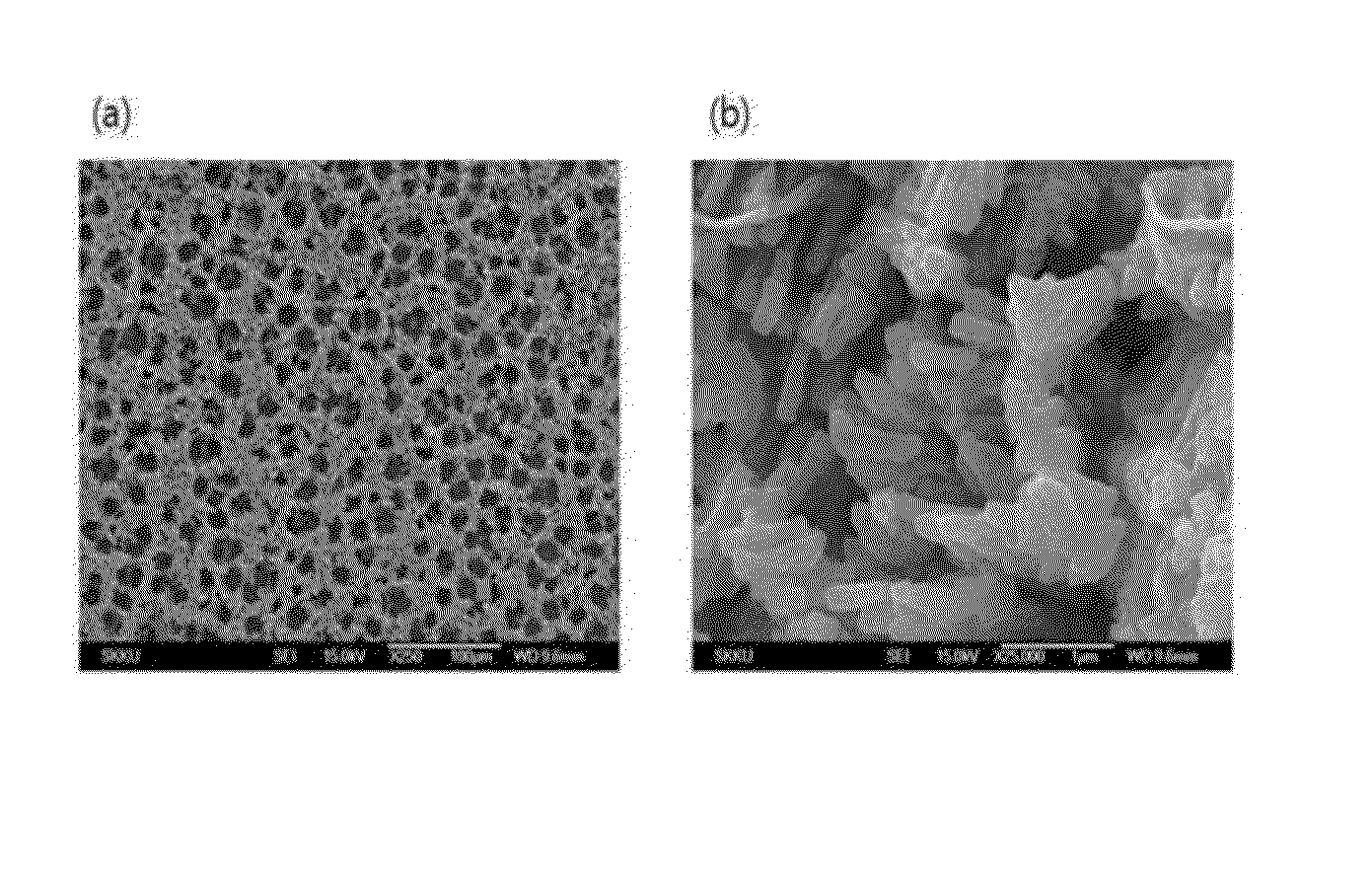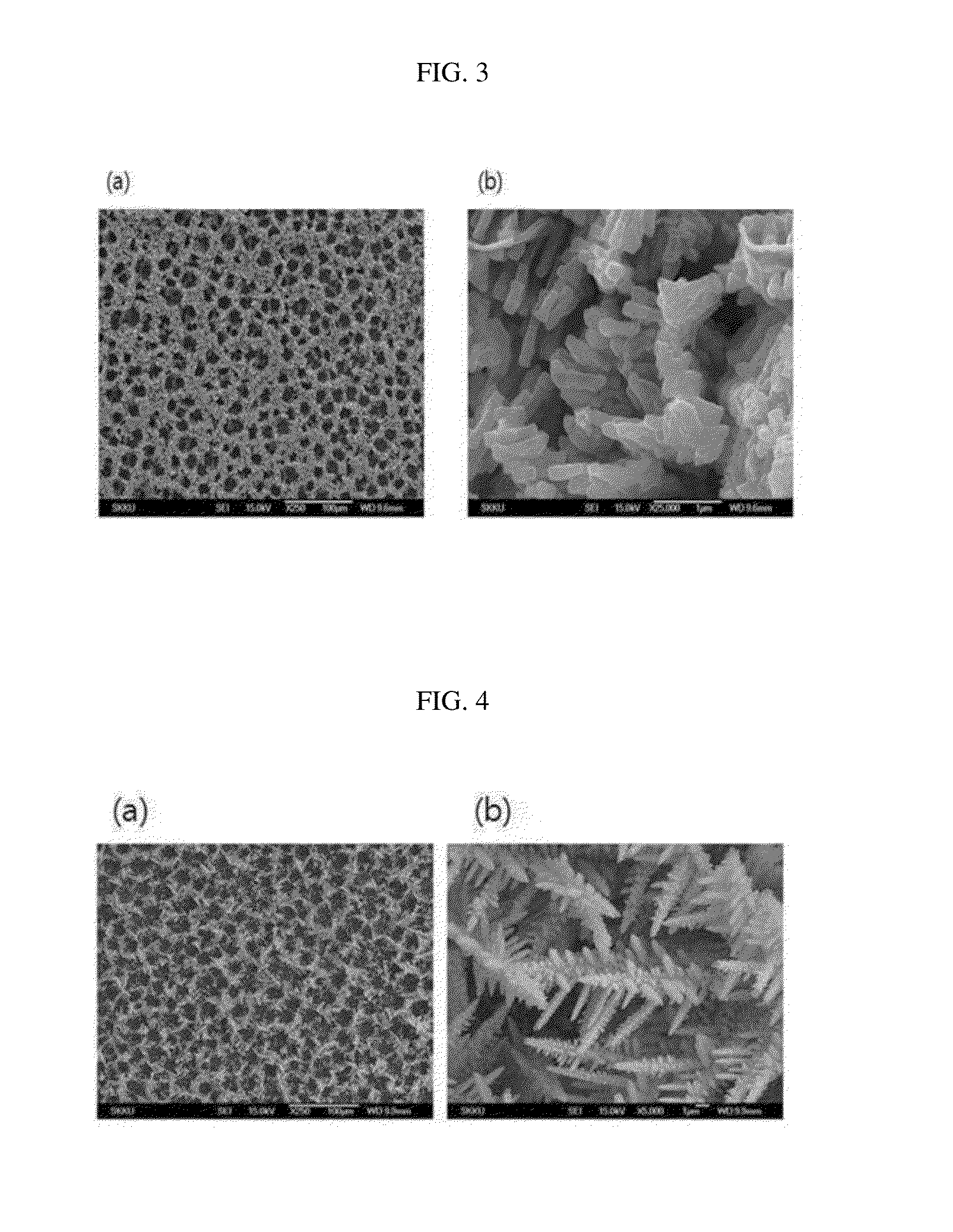Nano-porous electrode for super capacitor and manufacturing method thereof
a super capacitor and nanoporous technology, applied in the direction of electrolytic capacitors, electrotrophoretic coatings, coatings, etc., can solve the problems of reducing affecting the performance of the capacitor, so as to improve the specific surface area of the electrode, improve the energy density, power density, and the like of the capacitor, and increase the specific surface area
- Summary
- Abstract
- Description
- Claims
- Application Information
AI Technical Summary
Benefits of technology
Problems solved by technology
Method used
Image
Examples
example 1
Manufacture of Nano-Porous Electrode Using Manganese Oxide and Alloy
[0065]A titanium layer was formed into a thickness of 10 nm on a silicone matrix by sputtering titanium. Thereafter, a conductive platinum substrate in which a platinum layer was formed into a thickness of 200 nm on the titanium layer by sputtering titanium was used as a conductive metal matrix.
[0066]The conductive platinum substrate was used as a working electrode and the platinum plate was used as a counter electrode to form a porous manganese-containing structure on the manufactured conductive platinum substrate. A distance between a cathode and an anode was maintained to be 2 cm, and an Ag / AgCl reference electrode was used. In addition, MnSO4.H2O, and NH4Cl were contained as an electrolyte. In this case, concentrations of the electrolytes were 0.2M MnSO4.H2O, and 1M NH4Cl, respectively, and copper and tin were added thereto at a concentration of 0.01M. The conductive platinum substrate was immersed in 20 ml of t...
example 2
Manufacture of Nano-Porous Electrode Using Nickel Oxide and Alloy
[0067]The conductive platinum substrate was used as a working electrode and the platinum plate was used as a counter electrode to form a porous nickel-containing structure on the conductive platinum substrate manufactured in Example 1. In this case, a distance between a cathode and an anode was maintained to be 2 cm, and an Ag / AgCl reference electrode was used. In addition, NiCl2.6H2O, SnCl2.2H2O, and H2SO4 were contained as an electrolyte. In this case, a concentration of the electrolyte was 0.2M NiCl2.6H2O, 0.01M SnCl2.2H2O, and 1M H2SO4, respectively. The conductive platinum substrate was immersed in 20 ml of the prepared electrolyte, and electrodeposition was performed on the conductive platinum substrate for 1 minute by applying a voltage of −3 volt across the conductive platinum substrate to deposit a porous nickel / tin structure on the conductive platinum substrate, thereby manufacturing a porous nickel / tin elect...
example 3
Manufacture of Nano-Porous Electrode Using Cobalt Oxide and Alloy
[0068]The manufacture of the nano-porous electrode in Example 3 was performed in the same method as that in Example 2 except the following process. CoSO4.2H2O, SnCl2.2H2O and H2SO4 were contained as an electrolyte. In this case, concentrations of the electrolytes were 0.2M CoSO4.2H2O, 0.2M SnCl2.2H2O, and 1M H2SO4, respectively. A porous electrode formed with a porous cobalt / tin structure was manufactured. An annealing (oxidation) process was performed on the manufactured porous cobalt / tin electrode at 300° C. As a result, it could be found that a porous cobalt / tin structure was formed as shown in FIG. 4(a), and the porous cobalt / tin structure was formed as a number of dendritic structures of a protrusion shape as shown in FIG. 4(b).
PUM
| Property | Measurement | Unit |
|---|---|---|
| Thickness | aaaaa | aaaaa |
| Thickness | aaaaa | aaaaa |
| Thickness | aaaaa | aaaaa |
Abstract
Description
Claims
Application Information
 Login to View More
Login to View More - R&D
- Intellectual Property
- Life Sciences
- Materials
- Tech Scout
- Unparalleled Data Quality
- Higher Quality Content
- 60% Fewer Hallucinations
Browse by: Latest US Patents, China's latest patents, Technical Efficacy Thesaurus, Application Domain, Technology Topic, Popular Technical Reports.
© 2025 PatSnap. All rights reserved.Legal|Privacy policy|Modern Slavery Act Transparency Statement|Sitemap|About US| Contact US: help@patsnap.com



